The rockets will help scientists study how Earth's upper atmosphere is affected during the eclipse.
to do a little experimenting. They want to see how the sudden dimming during the eclipse affects us here on Earth, specifically how if affects communication systems. So they're launching three sounding rockets into the moon's shadow.
According to NASA, sounding rockets are small, low-cost sub-orbital vehicles that support scientific research between 100 and 1,400 kilometers into the atmosphere. There are 16 different types ofThe rockets will launch from Virginia at the space agency’s Wallops flight facility, which will be east of the path of totality. These same sounding rockets were also launched during last year’s annular eclipse. They’ve since been refurbished for this mission.
Here's how it’ll work. NASA will launch one rocket 45 minutes before peak eclipse coverage, and then another one during it. The final rocket will launch 45 minutes after peak eclipse. They'll head to the ionosphere, where they'll each release instruments to gather data. By launching the three rockets at those intervals, scientists will be able to see how the sudden disappearance of the sun affects the ionosphere. According to NASA, disturbances there have the potential to interfere with communications systems. By understanding the changes, scientists can improve models that can predict communication issues we may have on Earth.You can read more about what NASA hopes to learn from the launches on the NASA website.
United Kingdom Latest News, United Kingdom Headlines
Similar News:You can also read news stories similar to this one that we have collected from other news sources.
 You can be a NASA scientist during the April 8 total solar eclipseDigital content producer at News 5
You can be a NASA scientist during the April 8 total solar eclipseDigital content producer at News 5
Read more »
 NASA Asks U.S. Public To Look At Clouds During April 8’s Total Solar EclipseI’m the world's only solar eclipse journalist. I'm the editor of WhenIsTheNextEclipse.com and author of The Complete Guide To The Great North American Eclipse of April 8, 2024 and When Is The Next Eclipse? A traveler’s guide to total solar eclipses 2024-2034.
NASA Asks U.S. Public To Look At Clouds During April 8’s Total Solar EclipseI’m the world's only solar eclipse journalist. I'm the editor of WhenIsTheNextEclipse.com and author of The Complete Guide To The Great North American Eclipse of April 8, 2024 and When Is The Next Eclipse? A traveler’s guide to total solar eclipses 2024-2034.
Read more »
 Explosive 'devil comet' returns for 1st time in 71 years during April 8 eclipse, NASA saysOfficially named comet 12P/Pons-Brooks, the cryovolcanic comet is known as the 'devil comet' due to its formation of two 'horns' made up of ice and gas and periodic explosions.
Explosive 'devil comet' returns for 1st time in 71 years during April 8 eclipse, NASA saysOfficially named comet 12P/Pons-Brooks, the cryovolcanic comet is known as the 'devil comet' due to its formation of two 'horns' made up of ice and gas and periodic explosions.
Read more »
 Explosive 'devil comet' returns for 1st time in 71 years during April 8 eclipse, NASA saysOfficially named comet 12P/Pons-Brooks, the cryovolcanic comet is known as the 'devil comet' due to its formation of two 'horns' made up of ice and gas and periodic explosions.
Explosive 'devil comet' returns for 1st time in 71 years during April 8 eclipse, NASA saysOfficially named comet 12P/Pons-Brooks, the cryovolcanic comet is known as the 'devil comet' due to its formation of two 'horns' made up of ice and gas and periodic explosions.
Read more »
 Explosive 'devil comet' returns for 1st time in 71 years during April 8 eclipse, NASA saysOfficially named comet 12P/Pons-Brooks, the cryovolcanic comet is known as the 'devil comet' due to its formation of two 'horns' made up of ice and gas and periodic explosions.
Explosive 'devil comet' returns for 1st time in 71 years during April 8 eclipse, NASA saysOfficially named comet 12P/Pons-Brooks, the cryovolcanic comet is known as the 'devil comet' due to its formation of two 'horns' made up of ice and gas and periodic explosions.
Read more »
 NASA needs your smartphone during April’s solar eclipseAndrew Paul is Popular Science‘s staff writer covering tech news. Previously, he was a regular contributor to The A.V. Club and Input, and has had recent work featured by Rolling Stone, Fangoria, GQ, Slate, NBC, as well as McSweeney’s Internet Tendency. He lives outside Indianapolis.
NASA needs your smartphone during April’s solar eclipseAndrew Paul is Popular Science‘s staff writer covering tech news. Previously, he was a regular contributor to The A.V. Club and Input, and has had recent work featured by Rolling Stone, Fangoria, GQ, Slate, NBC, as well as McSweeney’s Internet Tendency. He lives outside Indianapolis.
Read more »
